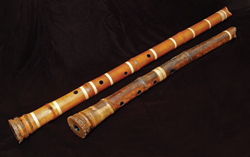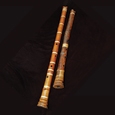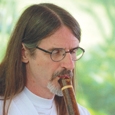The shakuhachi is one of several flutes used in traditional Japanese music and has a rich and colorful history. The flute is made from the very thick-walled root end of a specific variety of bamboo (madake) that is harvested in the wetland areas of China and Japan. It is not a fipple flute but is end blown and, thus, is often mistaken for a type of recorder. The blowing edge is formed by the diagonally cut bamboo and is often reinforced by a small bone or horn inlay.
The shakuhachi has five open holes and is tuned to a pentatonic scale. Pitches outside of the base scale are achieved by partially covering holes and slightly changing the blowing angle and breath strength. The standard (concert) length shakuhachi is tuned to a D pitch. As it exists today, the shakuhachi is a thoroughly modern instrument that can be played solo or in various ensemble configurations. It is well crafted to play in tune with both Japanese traditional instruments and modern Western instruments. Despite its rather rustic appearance, the shakuhachi is capable of deep, rich sounds. Furthermore, due to its unrefined nature, it lends itself to some very interesting and evocative playing techniques.
 The name, shakuhachi, derives from the length of the standard instrument. A Japanese unit of measure (roughly a foot) is the shaku. The shaku is divided into ten subunits called sun. The word for eight in Japanese is hachi. Hence the name shakuhachi refers to the length of one shaku and hachi sun. The standard length instrument is often called a 1.8 or hasun, an abbreviated pronunciation of hachisun. The instrument comes in a variety of lengths, the most popular being 1.8, 1.6, 2.0, and 2.4. The longer instruments are used for solo playing, and the 1.8 and 1.6 lengths are used in ensemble playing. Generically, all such instruments, of any length, are referred to as shakuhachi. (In the picture on the left are two shakuhachi of different lengths. The longer one is a 2.4 and the shorter is a (standard) 1.8.)
The name, shakuhachi, derives from the length of the standard instrument. A Japanese unit of measure (roughly a foot) is the shaku. The shaku is divided into ten subunits called sun. The word for eight in Japanese is hachi. Hence the name shakuhachi refers to the length of one shaku and hachi sun. The standard length instrument is often called a 1.8 or hasun, an abbreviated pronunciation of hachisun. The instrument comes in a variety of lengths, the most popular being 1.8, 1.6, 2.0, and 2.4. The longer instruments are used for solo playing, and the 1.8 and 1.6 lengths are used in ensemble playing. Generically, all such instruments, of any length, are referred to as shakuhachi. (In the picture on the left are two shakuhachi of different lengths. The longer one is a 2.4 and the shorter is a (standard) 1.8.)

A 1.6 Shakuhachi lying on the sheet music for an ensemble piece composed in the 19th century by Yoshikawa Kengyo II. The notation is Kinko School Shakuhachi notation and the title is Haru no Kyoku (Ode to Spring).
A Brief History
The shakuhachi made its first appearance in Japan around the eighth century. It came to Japan with an influx of Chinese culture that included the formal Chinese court system of social hierarchy and governing laws. Part of this court system included a type of music and a well-defined court orchestra. The ancestor of the shakuhachi was one of the instruments in this orchestra. It differed from the modern instrument in that it had six holes, was more slender, was lacquered throughout, and was made from a lighter bamboo.
Although the medieval Japanese court system eventually died out, a form of this type of orchestra still exists today, and a variant of the music is still performed. This music is called gagaku, the contemporary form of which is usually performed with a modern version of the shakuhachi replacing the six holed variety.
During the years following the adoption of the Chinese court system, several of the instruments included in the court orchestras became popular amongst the common people. Even though the music was quite rarified and intended for only the ears of the ruling class, it seems to have leaked out amongst the working people of the time. Three of the stringed instruments quickly became integrated into regular Japanese society: the koto, shamisen, and biwa. The shakuhachi, however, seems to have stayed within the castle walls.
Around the end of the ninth century, Japanese court music underwent an extensive renovation. The orchestras were pared down, and the shakuhachi and several other instruments were eliminated from them. Because the instrument had not become known beyond the courts, it seems to have disappeared entirely from Japan at that time.
Japan experienced several other big influxes of Chinese culture, one of which brought in what would become the Japanese form of Zen Buddhism. By the 13th century, and perhaps as early as the 11th century, monks from Buddhist temples in Japan made pilgrimages to China and brought back not only religious literature and meditation techniques used in Chinese temples, but also the shakuhachi. At this time monks used the instrument as a tool for meditation that was similar to that of chanting the sutras. It was thought that one could experience kensho (seeing into one’s own nature) by playing chant-based music on the shakuhachi.
Some of the lore of the period details how a samurai named Yoritake Ryoen reached this state of enlightenment after hearing the sound of the flute following a battle. Under the direction of the Zen master Shinchi Kakushin, Ryoen went on to found a sect devoted to the practice of the shakuhachi. This sect became known as the Fuke sect and played an integral role in the early history of the instrument.
By the sixteenth century the use of the shakuhachi had spread amongst the general populace. Although it continued to be an instrument of monks, it also took on a more secular role. It became popular in Japanese folk music (minyo) and also rejoined its fellow former court instruments (the koto and shamisen) in classical music (sankyoku) ensembles. Much of this type of music is performed regularly, unchanged, today.
The late nineteenth and early twentieth century, starting in the Meiji era and extending through the Showa period, saw a strong rise in the influence of the West on all aspects of Japanese culture. So it is not surprising that the music of the shakuhachi also felt this influence. Many Western musical aspects were adopted into Japanese classical compositions for traditional ensembles, which include the koto, shamisen, voice, and shakuhachi.
Solo shakuhachi pieces, the pieces collected from the temples, began to be written down and practiced in a secular environment. Virtuoso performers on the instrument emerged, and performers and composers began to create new material for the instrument. New schools of playing emerged and began to attract followers.
Toward the middle of the twentieth century several of these shakuhachi virtuosos traveled and spent time in Europe and North America. Today the instrument is taught both at universities and in independent schools and is played in the traditional manner for both solo and ensemble performances as well as in various non-traditional ways and settings.

On the left: This shows the root end of two shakuhachi. Note the difference in bore opening. This varies from maker to maker.
One the right: This shows the blowing end of two shakuhachi.
The Music
The shakuhachi is used in various forms of Japanese music, including court music (gagaku), folk music (minyo), small ensemble music (the older style sankyoku and the modern shinkyoku), and the music of the Buddhist tradition (honkyoku). The techniques involved in playing honkyoku music, however, are the ones that people associate most closely with the shakuhachi sound. (To learn more about the details of each of these types of music and how the shakuhachi fits into each framework, the bibliography at the end offers some resources.)
Honkyoku came about as an attempt to translate Buddhist chanting into something that could be produced on the shakuhachi. As this chant-based music evolved, particularly in the twentieth century, it began to acquire more musical qualities.
Several practitioners of this music began to add different techniques in order to imbue it with more emotional content as sutra chanting, by its very nature, is a bit static and monotone.
Dynamics were added since the more modern flutes (whose bores were lacquered with a hardened material) could produce a wide volume range. Note bending and slurring were other added techniques. The shakuhachi lends itself well to these techniques because it has open holes, and the blowing edge allows for a greater amount of movement than can occur with Western flutes. Percussive techniques, taking advantage of the fact that the shakuhachi has relatively large open finger holes, were another addition. Players also incorporated vibrato produced by shaking the head from side to side. They also added overblowing or noise techniques. All of these techniques were present in the original forms of honkyoku, but they were not used nearly to the degree that became popular in the twentieth century.
Beside chanting, another source of inspiration for the monks was nature sounds. Monasteries were often located in remote areas surrounded by forests, rivers, and mountains, so the monks listened to the sounds of the wind and wild animals. Some pieces of honkyoku are based on the sounds of cranes, deer, and pulsating winds. Monks also wandered into nearby villages and heard festival music. Some of the honkyoku repertoire reflects this as well.
For most of its existence honkyoku was an oral tradition. The pieces were passed on to new players who listened to and then tried to emulate the more experienced players. In the twentieth century several prominent students of the instrument visited temples and collected pieces. Notations were invented to try to capture all the playing techniques and subtleties of the instrument. Today there is no single notation for this type of music. The notation varies and is usually tied to a particular teacher or school of playing.
Of the different types of flutes around the world, the shakuhachi seems to be somewhat unique in its close association with a religion. It is a very flexible and evocative instrument capable of a great depth of emotion and demanding a great deal of dedication to learn. The word honkyoku refers to the fact that this music was meant to be internalized. Kyoku refers to music and hon refers to one self (or the first). Roughly translated, honkyoku means “my own music” or “original music.” Whether the music was chant based or nature based, it was created for personal reflection. The twentieth century brought about a slight change to this, freeing the music from the temples and placing it in the performance space; however the personal aspect of shakuhachi playing is still very much present. There are many more fascinating aspects to the shakuhachi, including the various schools of playing, different notations, types of flutes and their sound qualities, and virtuoso players who influenced how the music came to the modern world, to list a few.
Bibliography
Below is a collection of book titles, articles, recordings, and websites in no particular order that provide more in-depth information regarding the various aspects of the shakuhachi. This is by no means an exhaustive list. It has also been limited to publications in the English language.
The Shakuhachi a Manual for Learning by Christopher Yohmei Blasdel and Yuko Kamisango. ©1988. Ongaku No Tomo Sha Corp. Tokyo Japan. ISBN 4-276-13351-3
Zen Masters of Japan, The Second Step East by Richard Bryan McDaniel. ©2013. Richard Bryan McDaniel. ISBN978-4-8053-1272-8
The Annals of The International Shakuhachi Society Volume One by Various Authors. Published in 1987. ASIN B000GR4TJA
The Annals of The International Shakuhachi Society Volume Two by Various Authors. ©2005. The International Shakuhachi Society. ISBN 0-9711625-1-4
Blowing Zen Finding an Authentic Life by Ray Brooks. ©2000. Ray Brooks. ISBN 0-915811-85-5
Yearning for the Bell: A Study of Transmission in the Shakuhachi Honkyoku Tradition by Riley Kelly Lee (Doctoral Dissertation). ©1998, Riley Kelly Lee. UMI Dissertation Services UMI Number 9828066
Zen – Katsuya Yokoyama Plays Classical Shakuhachi Masterworks (2DC Set). Original Recording 1976 RCA Records Tokyo Japan. ©1988 WERGO Schallplatten GmbH, Mainz W. Germany.
Shakuhachi Music: A Bell Ringing in the Empty Sky – Goro Yamaguchi. Nonesuch Explorer Series Original Release 1969. ©2007, Nonesuch Records Inc.
Traditional Vocal and Instrumental Pieces: Shakuhachi, Biwa, Koto, Shamisen – Ensemble Nipponia. Nonesuch Explorer Series Original Release 1976. ©2008, Nonesuch Records Inc. The International Shakuhachi Society Website: http://www.komuso.com






